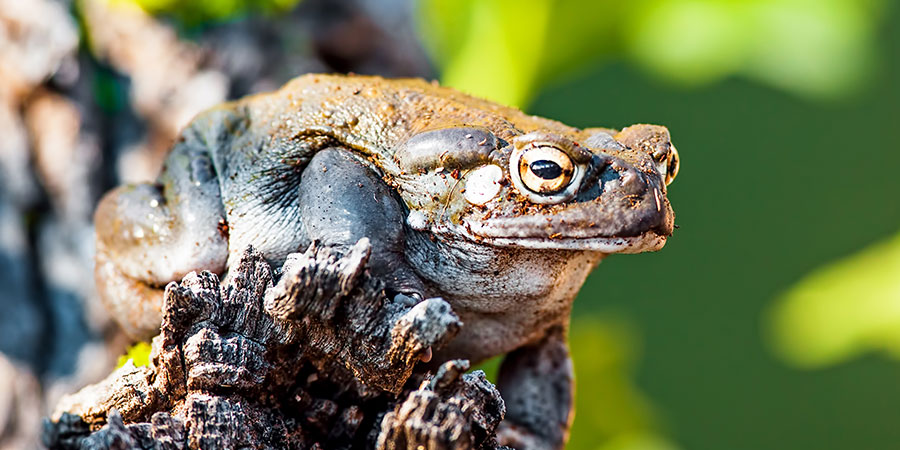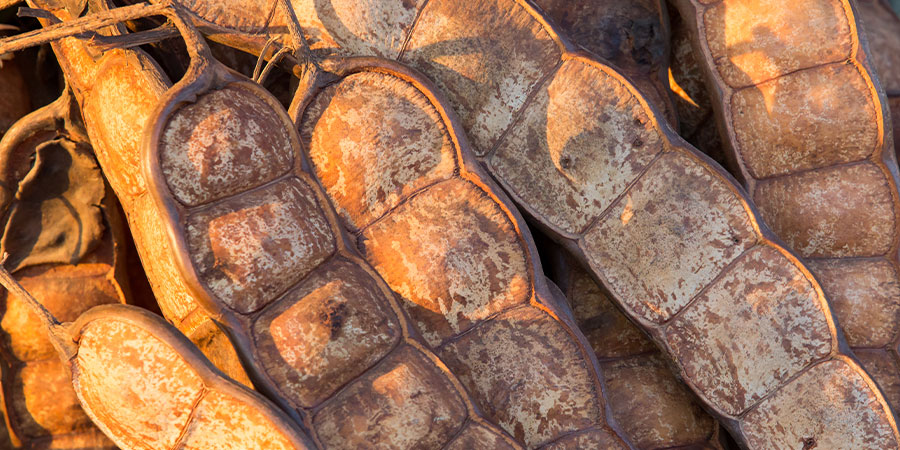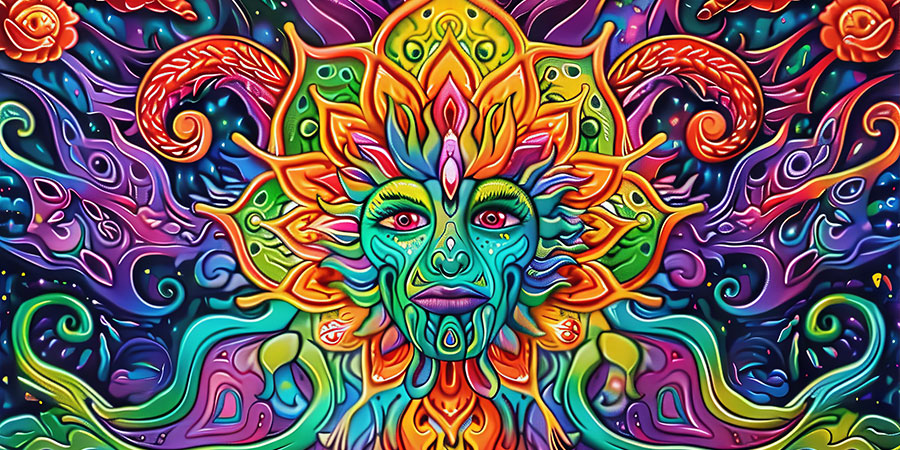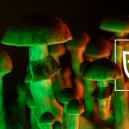What You Need to Know About 5-MeO-DMT
Published :
May 1st, 2024
Categories :
Research

Less famous than its relative DMT, 5-MeO-DMT is a much more potent entheogen. How does it work, and how is it different from DMT? Keep reading to find out.
5-MeO-DMT should not be confused with its better-known cousin, DMT. The former has a distinct chemical structure, history of use, and—perhaps most importantly—very pronounced effects. Let's delve into the world of this relatively unknown substance to understand more about its influence, potential applications, and how it was first discovered.
WHAT IS 5-MEO-DMT?

While its scientific name certainly doesn't roll off the tongue, 5-MeO-DMT is short for 5-methoxy-N, N-dimethyltryptamine. You'll find 5-MeO-DMT in many plant species, including the Fabaceae and Cactaceae families, alongside the venom of at least one rather large toad—the Colorado River toad (Bufo alvarius)—which inhabits the Sonoran desert between the Southern US and Northern Mexico. In fact, this may be where you first heard of 5-MeO-DMT, with tales of people licking toads to get high (spoiler: it's a terrible idea).
On a chemical level, 5-MeO-DMT belongs to the tryptamine class. Tryptamines are similar in structure to tryptophan (the precursor to serotonin) and act as non-selective serotonin receptor agonists. Furthermore, they are serotonin-norepinephrine-dopamine releasing agents (SNDRA), which means tryptamines like 5-MeO-DMT can catalyse the release of feel-good chemicals such as serotonin, epinephrine, and dopamine. This action ultimately results in a profound psychedelic experience, prompting significant changes to sensory perception, mood, and thought patterns.
WHERE DOES 5-MEO-DMT COME FROM?

The most common source is Anadenanthera peregrina. This plant, also known as "yopo" or "choba", is native to the Caribbean and a large portion of South America. However, the molecule is present in dozens of plant species, including the roots of the telegraph plant, the bardi bush, and the bark of the auri tree. Of course, 5-MeO-DMT is also present in the toxic substance secreted by the Colorado River toad. And, yes, before you ask, it is very harmful, as the secretion not only contains 5-MeO-DMT but cardiac glycosides, a class of compounds that affect heart rate and could lead to death!
5-MEO-DMT: A QUICK HISTORY
In Central and South America, snuff containing 5-MeO-DMT has been identified that dates back hundreds of years. Even today, indigenous Amazonian tribes hold knowledge on how to prepare these elusive snuffs from the plethora of 5-MeO-DMT-containing plants growing abundantly in the local environment.
At the end of the 15th century, accounts of ceremonial use of this entheogenic plant in the Amazon reached Europe. However, 5-MeO-DMT was only synthesised in a lab in 1936.
In the '70s and '80s, this substance could be legally purchased in most countries worldwide. In the US, some entheogenic sects emerged, like the "Church of the Tree of Life", which regularly held ceremonies encompassing the use of 5-MeO-DMT as a sacrament. In fact, you could even purchase 5-MeO-DMT at this church. They would send you mail containing parsley leaves sprinkled with the entheogen.
The extraction, use, and commerce of 5-MeO-DMT remained unregulated in most countries until the early 2000s. Be careful, though! It is illegal to purchase 5-MeO-DMT online in certain countries or to have it shipped to a locale where the substance is prohibited.
WHAT ARE THE EFFECTS OF 5-MEO-DMT?

5-MeO-DMT is potent and often accompanied by sensory overload and loss of physical coordination and control. "Trip reports" of this substance are few and far between, although some describe it as a body and consciousness "explosion".
There is said to be a loss of ego in which interior and exterior dissolve into one, resembling something like a near-death experience. You shouldn't expect colourful visuals like those experienced on magic mushrooms or LSD, but more a shift in perception—of yourself and the universe around you. Effects usually come in waves, and users may continue to experience them over the following days and weeks.
IS 5-MEO-DMT SIMILAR TO DMT?
Let's make it very clear: DMT and 5-MeO-DMT are two very different substances. This distinction is vital to avoid dangerous and potentially harmful experiences. The two substances only differ slightly in their chemical structure, but the few extra elements in 5-MeO-DMT make all the difference.
DMT stands for N,N-dimethyltryptamine, and is present in numerous plant and animal species. Many believe it to be a foundational molecule of life. Moreover, some animal model studies suggest that rats may be able to produce DMT in correspondence with specific neurological states (Dean et al., 2019). The researchers concluded that there is a "possibility that this phenomenon may occur similarly in human brains”, but their thesis has yet to be confirmed or discarded.
DMT is primarily known as a critical ingredient in the Amazonian ayahuasca brew. Moreover, DMT induces significantly different effects from 5-MeO-DMT in isolation. While the 5-MeO-DMT experience is more like a shift in perspective reality (a sensation some describe as being similar to a near-death experience), DMT is said to be much more visual, transporting you to other dimensions where you may encounter celestial beings and experience a deep feeling of love for the universe.
HOW DO YOU TAKE 5-MEO-DMT?

The two most common ways to take 5-MeO-DMT are to vaporize and smoke it or to snort (insufflate) it. When vaporizing or smoking, effects come on almost immediately, after about thirty seconds. The peak comes after roughly 15–20 minutes and effects last up to 30–45 minutes. Interestingly, 5-MeO-DMT produces its effects even at very low doses.
When insufflating, it may take up to five minutes to feel the first effects. The peak will be between 10 and 30 minutes later, with effects waning after 30 to 45 minutes. Swallowing 5-MeO-DMT is not recommended since the results are highly unreliable, so you can forget about licking venomous toads!
IS 5-MEO-DMT SAFE?
When taking either of these substances, it's crucial to remember that 5-MeO-DMT is regarded as being four to six times more potent than DMT. That said, how each substance is consumed will also affect its route in the body and subsequent effects. However, neither variant has been extensively studied for its safety, at least in human model studies. A positive, at least, is that 5-MeO-DMT does appear to show low potential for addiction, according to researchers from the John Hopkins University School of Medicine (Davis et al., 2018).
DOES 5-MEO-DMT HAVE MEDICAL APPLICATIONS?

Pioneering studies exploring the therapeutic properties of 5-MeO-DMT are looking to see how the tryptamine alkaloid influences conditions like depression and anxiety, as well as addiction—when used in conjunction with ibogaine (Davis et al., 2019). We should stress, however, that these studies are at the earliest stage of development, with only a handful of sponsored trials underway. When dealing with any substance that affects the human mind, control measures are incredibly difficult to quantify and, as a result, have slowed interest in researching 5-MeO-DMT.
5-MEO-DMT: AN INTERESTING YET VASTLY UNDERSTUDIED COMPOUND
While we know much about the compound's psychoactive influence, courtesy of Amazonian tribes and the divisive "Church of the Tree of Life", we are yet to understand how it could be leveraged in a clinical setting. Studies are limited, with many research institutes reluctant to start because of psychopharmacology's expense and resource-intensive nature. For now, we can only marvel at the recreational potential of 5-MeO-DMT and its profound impact on how we view ourselves within the universe.














